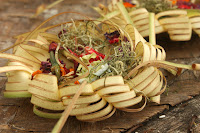 |
| Banten (palm frond offering with flowers) made at MATCHA |
Granted, the staples we used to hold it together are not as elegant as the mini-skewer lidih coconut frond spines used in Bali, and the silk flowers don't have the scent of real blossoms, but it was close enough to remind us of the offerings at Besaki mother temple in Bali last Dec.
 |
| Offerings at Besaki, Bali |
 |
| Fancy cut flower shaped palm frond offerings |
 |
| Square offerings and priest's bell |
My daughter thought she recognized the priestess we met at Besaki in one of the movie clips playing in the galleries.
 |
| Priestess at Besaki mother temple, Bali |
 |
| Besaki priestess helping Livi re-tie her sarong. |
Next, a bite at the museum cafe -- we picked a tasty udon bowl rather than the lamb sate sampler plate. If you want great Indonesian food, go to Sekti's favorite: Jayakarta on University in Berkeley. Given my cooking, I think they're the only reason he's managed to stick around in the States this long...though I can produce a good pot of what we call sop Ibu (Mother's soup) - taught to me by Sekti's mom.
Our thoughtful friend reserved a front row seat on the floor in the Samsung Hall for us to watch the dance performance by Gadung Kasturi. Director Kompiang Metri-Davies (a friend and customer at Gardensia) and her co-dancers were enchanting to watch in the last piece, Legong Supraba Duta. The flick of Kompiang's hands, eyes and head were smooth and graceful without sacrificing crispness, and she tops it off with that provocative Balinese half-wink smirk followed by the flash of a super wide-eyed glare. Bette Davis got nothin' on Kompiang!
Since I don't have a video of Gadung Kasturi's performance, here's a clip of Legong that I took in Ubud, Bali.
The dancer in red is dancing the same Condong charater/role that Kompiang's daughter danced, third piece into the program. The dancers in the video clip are mature and skillful in their dancing, but to me, it's is even more enthralling to watch young girls like Kompiang's daughter perform this dance -- as it is traditionally performed by pre-adolescent girls and has an air of eager energy and mixed with innocence.
Lastly, to the exhibit:
Probably my favorite items were the two early 20th century photos of Legong dancers in gallery 3. (See one in the rotating banner photos on the exhibit web page.) It's interesting to compare the costumes in the photos with the standard Legong costumes of today.
Also high on my list were:
(You can't take pictures in the gallery, but here are some representative photos from Gardensia)
 |
| Rain drums at Gardensia |
1,000 year old bronze rain drum head in gallery 1. (You can get a whole one -- though not 1,000 years old -- at Gardensia),
the carved door in gallery 2 (Balinese doors get snatched up at Gardensia as soon as we get them),
 |
| Balinese door with wayang figures at Gardensia |
 | |||
| Balinese door at Gardensia |
and the bale (pavillion) in front of gallery 3.
 |
| Ceiling of Balinese pavilion (bale) at Besaki |
| Javanese carved teak pavilion (joglo) |
 |
| Ceiling of Javanese pavilion (joglo) at Gardensia |
If you have a hankering to sit (or lie down) in a pavilion like this, feel free to stop by Gardensia to take a break among artifacts from Bali and all over the Indonesian archipelago. Some people tell us it's like visiting a museum, except you can touch, sit on, and pick up the items (OK, some of the items. You won't want to be hefting stone Buddha statues). Not only that, we have plants and running fountains to give the feeling you're in the lush tropics.
I have only one constructive comment about the exhibit: the decorations in the North Court looked sparse and dry. If you've been to Bali you know that everywhere you look -- every inch -- looks alive and vibrant. I would have preferred all the flags, umbrella, janur (woven offerings), and statues to be clustered in one area (e.g., by the pavilion) with some flowers and plants and a fountain (would introducing wet and living material in the building be dangerous to the collections?) Then, of course, if you really like something at Gardensia, you can buy it and take it home to enjoy every day. (If you can't live in Bali, next best thing is to bring some Bali home.)
If you missed yesterday's Sacred Offerings MATCHA, there will be more throughout the summer, and the Bali exhibit runs through September. It's worth the visit! [Oh, darn, there will be so much to see in the upcoming months that I meant to renew our membership to the museum last night, but they had to usher me out of the galleries as the doors were closing, so I forgot.]













